Mybatis(二):怎样使用Mybatis,
一、创建项目(本文以Idea基于Maven构建的项目为例)
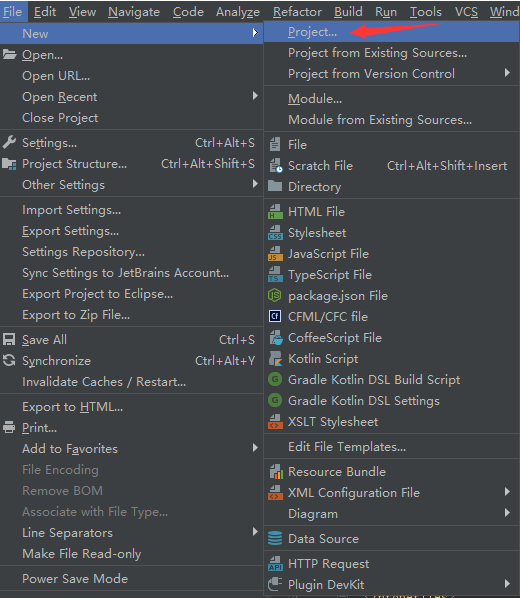



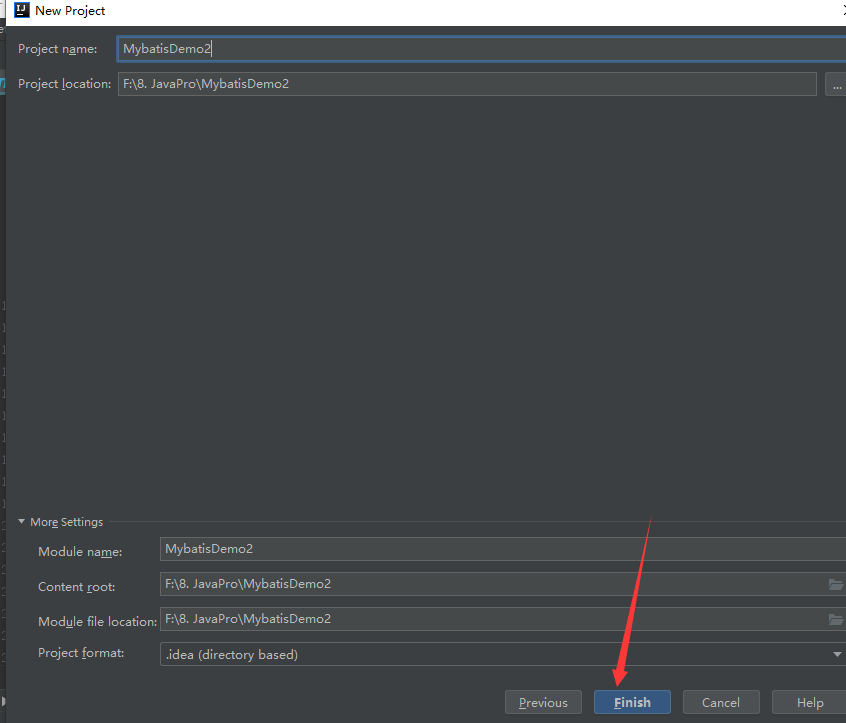
二、在配置文件中添加依赖包
- pom.xml配置文件中添加Mybatis、JDBC驱动、log4j日志管理的包依赖
- 完整代码如下:

![]()
<?xml version="1.0" encoding="UTF-8"?>
<project xmlns="http://maven.apache.org/POM/4.0.0" xmlns:xsi="http://www.w3.org/2001/XMLSchema-instance"
xsi:schemaLocation="http://maven.apache.org/POM/4.0.0 http://maven.apache.org/xsd/maven-4.0.0.xsd">
<modelVersion>4.0.0</modelVersion>
<groupId>com.zhurouwangzi</groupId>
<artifactId>MybatisDemo</artifactId>
<version>1.0-SNAPSHOT</version>
<name>MybatisDemo</name>
<!-- FIXME change it to the project's website -->
<url>http:
//www.example.com</url>
<properties>
<project.build.sourceEncoding>UTF-8</project.build.sourceEncoding>
<maven.compiler.source>1.7</maven.compiler.source>
<maven.compiler.target>1.7</maven.compiler.target>
<!--mybatis版本-->
<mybatis.version>3.2.7</mybatis.version>
<!--log4j版本-->
<slf4j.version>1.6.6</slf4j.version>
<log4j.version>1.2.12</log4j.version>
</properties>
<dependencies>
<dependency>
<groupId>junit</groupId>
<artifactId>junit</artifactId>
<version>4.11</version>
<scope>test</scope>
</dependency>
<!-- mybatis核心包 -->
<dependency>
<groupId>org.mybatis</groupId>
<artifactId>mybatis</artifactId>
<version>${mybatis.version}</version>
</dependency>
<!-- mysql驱动包 -->
<dependency>
<groupId>mysql</groupId>
<artifactId>mysql-connector-java</artifactId>
<version>5.1.29</version>
</dependency>
<!-- 日志文件管理包 -->
<!-- log start -->
<dependency>
<groupId>log4j</groupId>
<artifactId>log4j</artifactId>
<version>${log4j.version}</version>
</dependency>
<dependency>
<groupId>org.slf4j</groupId>
<artifactId>slf4j-api</artifactId>
<version>${slf4j.version}</version>
</dependency>
<dependency>
<groupId>org.slf4j</groupId>
<artifactId>slf4j-log4j12</artifactId>
<version>${slf4j.version}</version>
</dependency>
<dependency>
<groupId>org.junit.jupiter</groupId>
<artifactId>junit-jupiter-api</artifactId>
<version>RELEASE</version>
<scope>compile</scope>
</dependency>
</dependencies>
<build>
<pluginManagement><!-- lock down plugins versions to avoid using Maven defaults (may be moved to parent pom) -->
<plugins>
<!-- clean lifecycle, see https:
//maven.apache.org/ref/current/maven-core/lifecycles.html#clean_Lifecycle -->
<plugin>
<artifactId>maven-clean-plugin</artifactId>
<version>3.1.0</version>
</plugin>
<!--
default lifecycle, jar packaging: see https:
//maven.apache.org/ref/current/maven-core/default-bindings.html#Plugin_bindings_for_jar_packaging -->
<plugin>
<artifactId>maven-resources-plugin</artifactId>
<version>3.0.2</version>
</plugin>
<plugin>
<artifactId>maven-compiler-plugin</artifactId>
<version>3.8.0</version>
</plugin>
<plugin>
<artifactId>maven-surefire-plugin</artifactId>
<version>2.22.1</version>
</plugin>
<plugin>
<artifactId>maven-jar-plugin</artifactId>
<version>3.0.2</version>
</plugin>
<plugin>
<artifactId>maven-install-plugin</artifactId>
<version>2.5.2</version>
</plugin>
<plugin>
<artifactId>maven-deploy-plugin</artifactId>
<version>2.8.2</version>
</plugin>
<!-- site lifecycle, see https:
//maven.apache.org/ref/current/maven-core/lifecycles.html#site_Lifecycle -->
<plugin>
<artifactId>maven-site-plugin</artifactId>
<version>3.7.1</version>
</plugin>
<plugin>
<artifactId>maven-project-info-reports-plugin</artifactId>
<version>3.0.0</version>
</plugin>
</plugins>
</pluginManagement>
</build>
</project>
View Code

- 在src下添加一个resource文件夹,然后鼠标右键Mark Directory As Resources Root

- 在src/resource文件夹下创建SqlMapConfig.xml作为Mybatis的全局配置文件
- 在src/resource然后再创建一个log4j.properties文件用来配置日志文件的配置
- 在src/resource再创建一个sqlmap文件夹用来存放Mybatis的映射文件
- 创建好的项目结构如下:

三、设置Mybatis相关配置文件
- log4j.properties配置文件的内容如下:
# Global logging configuration
log4j.rootLogger=DEBUG, stdout
# Console output...
log4j.appender.stdout=org.apache.log4j.ConsoleAppender
log4j.appender.stdout.layout=org.apache.log4j.PatternLayout
log4j.appender.stdout.layout.ConversionPattern=%5p [%t] - %m%n
- SqlMapConfig.xml配置文件内容如下:
<?xml version="1.0" encoding="UTF-8" ?>
<!DOCTYPE configuration
PUBLIC "-//mybatis.org//DTD Config 3.0//EN"
"http://mybatis.org/dtd/mybatis-3-config.dtd">
<configuration>
<!-- 和spring整合后 environments配置将废除-->
<environments default="development">
<environment id="development">
<!-- 使用jdbc事务管理-->
<transactionManager type="JDBC" />
<!-- 数据库连接池-->
<dataSource type="POOLED">
<property name="driver" value="com.mysql.jdbc.Driver" />
<property name="url" value="jdbc:mysql://localhost:3306/web_test3?characterEncoding=utf-8" />
<property name="username" value="root" />
<property name="password" value="root" />
</dataSource>
</environment>
</environments>
</configuration>
四、创建实体类
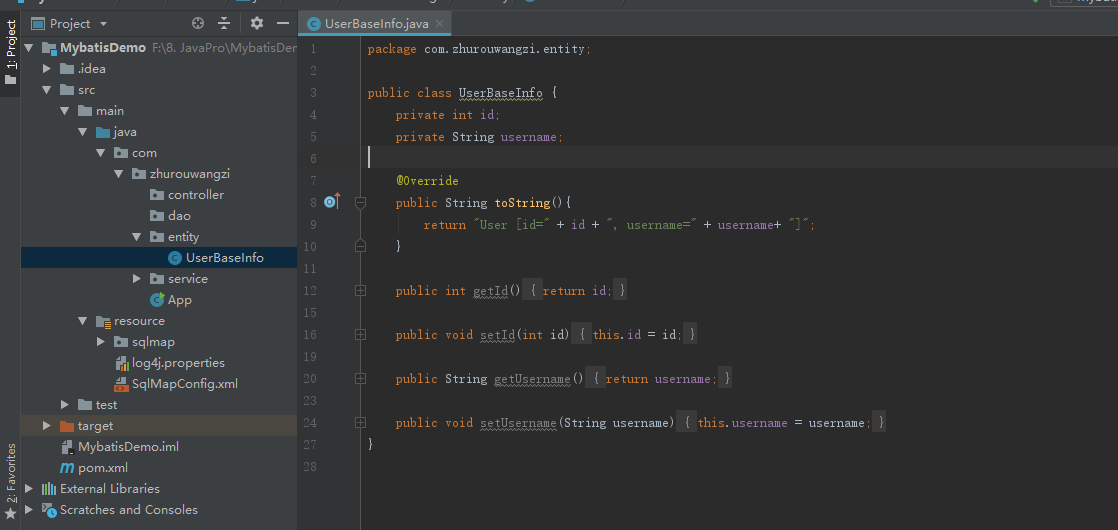

![]() package com.zhurouwangzi.entity;
public class UserBaseInfo {
private int id;
private String username;
@Override
public String toString(){
return
package com.zhurouwangzi.entity;
public class UserBaseInfo {
private int id;
private String username;
@Override
public String toString(){
return "User [id=" + id + ", username=" + username+ "]"
;
}
public int getId() {
return id;
}
public void setId(
int id) {
this.id =
id;
}
public String getUsername() {
return username;
}
public void setUsername(String username) {
this.username =
username;
}
}
View Code
- 在src/resource/sqlmap文件夹下添加user.xml作为UserBaseInfo的映射文件
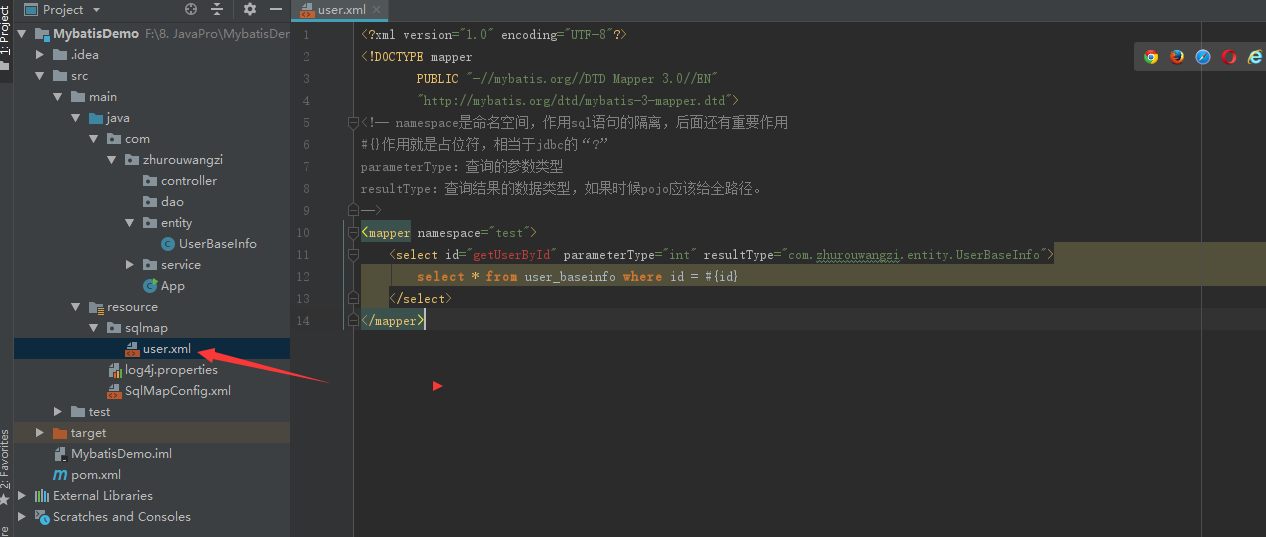

![]()
<?xml version="1.0" encoding="UTF-8"?>
<!
DOCTYPE mapper
PUBLIC "-//mybatis.org//DTD Mapper 3.0//EN"
"http://mybatis.org/dtd/mybatis-3-mapper.dtd">
<!--
namespace是命名空间,作用sql语句的隔离,后面还有重要作用
#{}作用就是占位符,相当于jdbc的“?
”
parameterType:查询的参数类型
resultType:查询结果的数据类型,如果时候pojo应该给全路径。
-->
<mapper namespace="test">
<select id="getUserById" parameterType="int" resultType="com.zhurouwangzi.entity.UserBaseInfo">
select * from user_baseinfo where id =
#{id}
</select>
</mapper>
View Code
- 在SqlMapConfig.xml配置文件中添加<Mappers>配置:
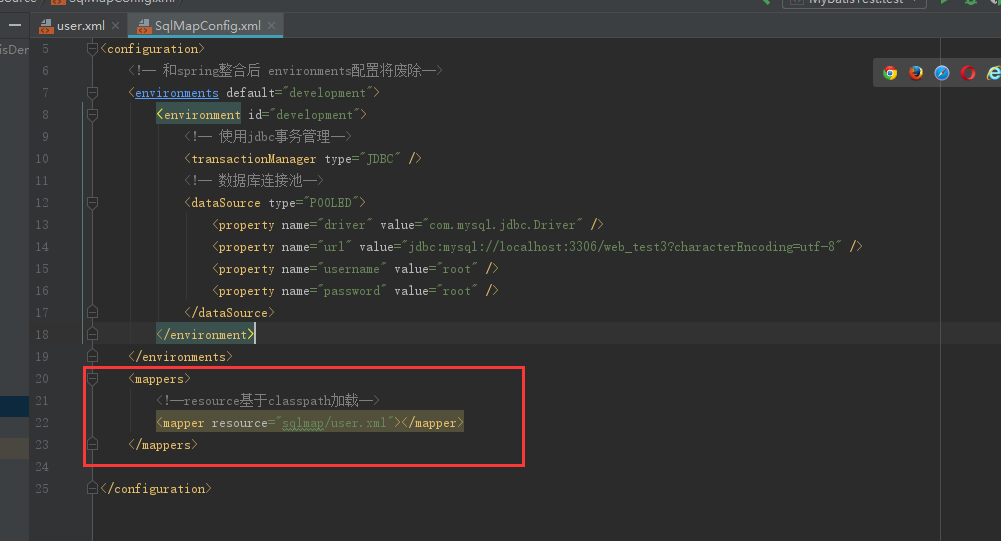
五、用测试方法区测试

![]() package com.zhurouwangzi.service;
import com.zhurouwangzi.entity.UserBaseInfo;
import org.apache.ibatis.io.Resources;
import org.apache.ibatis.session.SqlSession;
import org.apache.ibatis.session.SqlSessionFactory;
import org.apache.ibatis.session.SqlSessionFactoryBuilder;
import org.junit.jupiter.api.Test;
import java.io.InputStream;
public class MybatisTest {
@Test
public void
package com.zhurouwangzi.service;
import com.zhurouwangzi.entity.UserBaseInfo;
import org.apache.ibatis.io.Resources;
import org.apache.ibatis.session.SqlSession;
import org.apache.ibatis.session.SqlSessionFactory;
import org.apache.ibatis.session.SqlSessionFactoryBuilder;
import org.junit.jupiter.api.Test;
import java.io.InputStream;
public class MybatisTest {
@Test
public void test()
throws Exception{
//1.创建一个SqlSessionFactoryBuilder对象
SqlSessionFactoryBuilder sqlSessionFactoryBuilder =
new SqlSessionFactoryBuilder();
//2.加载配置文件
InputStream inputStream = Resources.getResourceAsStream("SqlMapConfig.xml"
);
//3.创建SqlSessionFactory工厂对象
SqlSessionFactory sqlSessionFactory =
sqlSessionFactoryBuilder.build(inputStream);
//4.获取SqlSession对象
SqlSession sqlSession =
sqlSessionFactory.openSession();
//5.执行sql语句
UserBaseInfo userBaseInfo = sqlSession.selectOne("getUserById", 16
);
System.out.println(userBaseInfo);
//关闭资源
sqlSession.close();
}
}
View Code
运行结果如下:
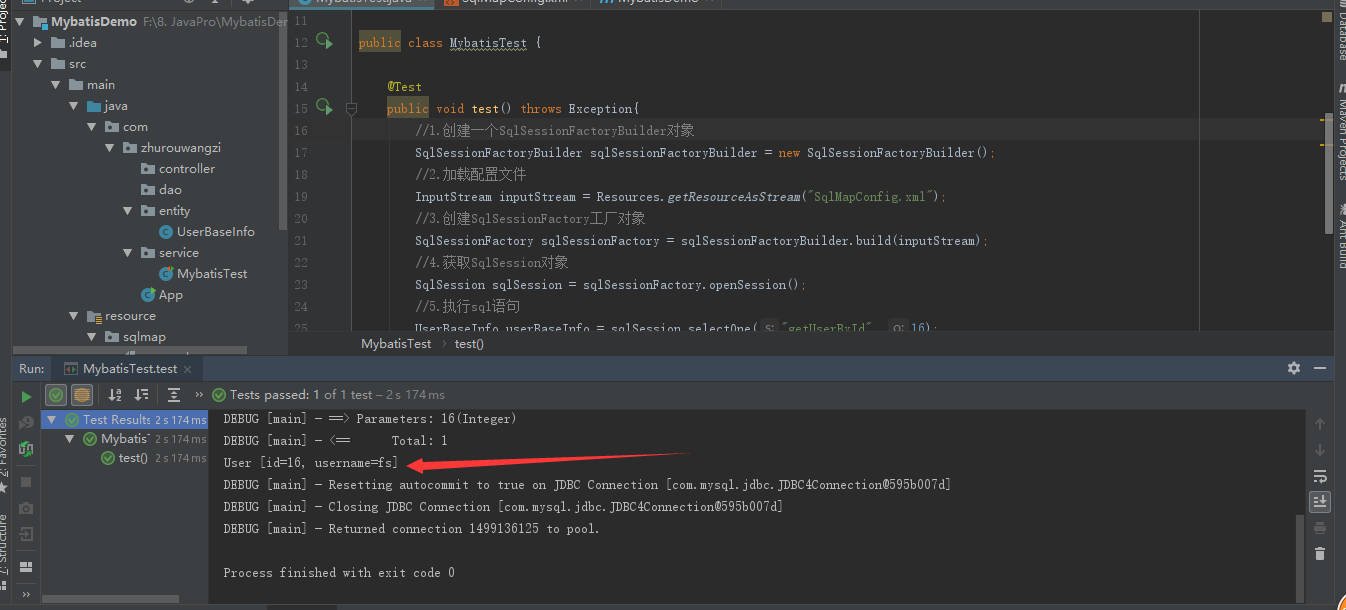
















用户点评